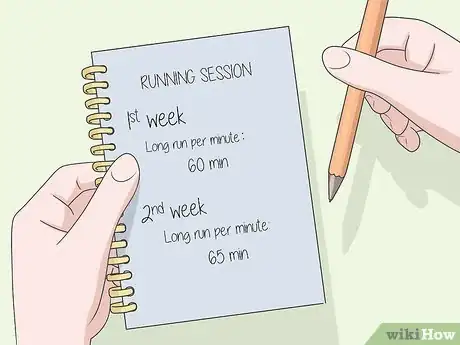This article was co-authored by Kai Ng and by wikiHow staff writer, Kyle Hall. Kai Ng is a USATF and RRCA Certified Running Coach at Run Coach Kai. Kai has competed in over 55 races and over 15 marathons, and has trained with 16x USA and World record holder Patti Catalano Dillonso. He specializes in coaching runners of all levels and showing people that everyone can be a runner. Kai is committed to helping his clients reach their goals by showing them how to run with proper form and holding them accountable to train consistently.
There are 13 references cited in this article, which can be found at the bottom of the page.
wikiHow marks an article as reader-approved once it receives enough positive feedback. In this case, 100% of readers who voted found the article helpful, earning it our reader-approved status.
This article has been viewed 206,081 times.
Being a great cross country runner requires speed, endurance, and commitment. You’ll need to train hard and practice as much as you can, but once you start seeing yourself improve, it will all be totally worth it. There are simple changes you can make to become a better cross country runner right away, like fine-tuning your running form and strapping on the right shoes. For long-term improvement, you’ll need to stick to a training schedule and set goals for yourself. When it comes time to race, there are a few strategies you can try that will help give you an edge over your competitors.
Steps
Training for Cross Country
-
1Start training before the cross country season starts. Training for cross country is a gradual process, so it’s important that you start early to give yourself time to build up your endurance and speed. This is especially important if you haven’t been running at all in the off season. Start training in the summer so you’re better prepared when cross country season starts in the fall. Then, continue training regularly throughout the season.[1]
- Train for cross country every day of the week if you’re able to. Aim to do one specific training exercise per day.
-
2Set running goals for yourself to help guide your training. Setting goals will give you something to work towards throughout the season and help you measure how much you’ve improved as a runner. Make your goals specific and come up with a timeline to achieve them within, like by the end of the cross country season.[2]
- For example, your goal could be to beat your best time on a 5K race by the end of the season or to run a full race without having to stop.
Advertisement -
3Incorporate tempo runs into your training. Tempo runs are 20-30 minute runs at a pace that’s slightly slower than your racing pace. They should be challenging but not exhausting. Tempo runs are a good way to build your endurance and train your body to handle fast paces over long distances.[3]
- Do 1 tempo run per week.[4]
-
4Try interval training. Interval training for cross country involves running at a fast pace for a set distance, jogging or walking afterward to recover, and then repeating several times. It’s a good way to improve your running speed. Try interval training once a week during the running season. A few intervals you can try are:[5]
- 400 meters (440 yd) 10 times with a 400 m (440 yd) jog in between intervals.
- 600 meters (660 yd) 6 times with a 200 m (220 yd) jog in between intervals.
- 1,000 meters (1,100 yd) 5 times with a 3-minute walk in between intervals.
-
5Do fartleks to improve your speed. Fartlek is a Swedish word for “speed play.” To run a fartlek, run for 30-45 minutes and continue changing your pace throughout. For example, start by jogging for 5 minutes, then sprint for 20 seconds, then slow back down to a jog until you’ve recovered a bit before sprinting again. Continue these pace changes throughout your run. Practicing fartleks will help prepare you for changing your pace during a race.[6]
- Do fartleks 1 day per week.
-
6Go for long runs. Long runs are 60-90 minute runs that you can do at a conversational pace, or slow enough that you could have a conversation with someone comfortably. The goal is to run the whole time at the same pace without having to stop or slow down. Slow runs are great for improving your endurance. Go for 1 long run per week while you’re training.[7]
Tip: Find someone to go on your long runs with you. You’ll be more motivated to stick with them if you have someone to talk to while you run.
-
7Do easy runs every other day of the week to let your body recover. Run at a casual, conversational pace for 30 minutes on your easy days. Taking a break between harder workouts will give your body a chance to recover, which will help prevent injuries and ensure that you’re performing your best. You can also take one day off per week to rest and not run at all.[8]
- For example, you could do your easy runs on Tuesdays, Thursdays, and Saturdays. Your harder workouts, like interval training, fartleks, and tempo runs, would be on Mondays, Wednesdays, Fridays, and Saturdays.
-
8Increase the duration of your exercises as the season progresses. Every 1-2 weeks, add 5 minutes to each of your runs, including your tempo runs, fartleks, interval training, and long runs. That way, you’ll gradually build up your endurance and speed throughout the running season.[9] [10]
- For example, the first week of training you might go for a 60-minute long run. Then, you would go for a 65-minute long run the next week. The following week, your long run would be 70 minutes, and so on.
-
1Practice good long-distance running form. Stand up straight as you run and avoid leaning forward at your waist. Run so your feet land close to your center directly underneath your body. Don’t run using long strides since it puts unnecessary pressure on your legs.[11] You should also keep your elbows bent at 90 degrees or less, and let your arms move naturally forward and backward. Avoid pumping your arms or swinging them far out in front of you. By maintaining good form while you run, you’ll increase your efficiency and be less at risk of injuring yourself.
Tip: If you’re on a cross country team, ask your coach to help you with your form. They’ll be able to watch you run and see any mistakes you might be making.
-
2Invest in a pair of cross country spikes. Cross country spikes are shoes designed specifically for cross country running. They have metal spikes on the sole that provide better traction and make running on soft terrains easier. Regular trail shoes can work for cross country, but spikes will give you a competitive edge in races and make you more efficient while training.[12]
- You can find cross country spikes online and in shoe stores that sell athletic shoes.
- Read online reviews of different spikes to see which ones are the best quality within your price range.
-
3Prepare in advance for cold and rainy racing conditions. There may be times when you find yourself racing in cold, rainy weather. To better prepare, practice running in the cold and the rain throughout the season if you can. That way, you’ll be more mentally and physically comfortable if you have to do it during a race. You’ll also have a better sense of how to pace yourself when it’s cold and raining and you’re drenched.[13]
- If you show up to a race and it’s raining, stay as dry as you can until the race starts by wearing a poncho and covering your shoes with plastic bags. The longer you stay dry and warm, the better you’ll perform.
- Wear moisture-wicking layers that are well ventilated if the forecast is looking rainy for a race. You’ll have layers to keep you warm, but you can also take layers off if you start to get overheated.
-
4Stay present while you run to avoid obstacles and injury. Cross country running trails can be covered in roots, rocks, mud, branches, and other obstacles that can pose a tripping hazard if you’re not being careful. Whether you’re training or racing, keep your eyes ahead of you on the trail and stay focused so you can avoid obstacles and slow your pace if necessary.[14]
- Avoid looking straight down at the ground as you run since it will slow you down. Look forward and scan the trail ahead of you instead.
- Don’t feel bad if you fall during a race—it happens to every runner at some point. If you’re seriously injured or in a lot of pain, ask for help and get medical attention. Otherwise, see if you can get up and finish the race.
-
5Practice running on different types of terrain. Cross country races can take place on hills, soft dirt, rocky trails, and other types of terrain. The more comfortable you are running on different trail types, the more prepared you’ll be for races, regardless of where they’re held. Vary what trails you’re training on every week, and look for trails that are different from what you’re used to.
- For example, if you usually train on trails that run through a relatively flat park, look for trails that have a lot of inclines that you can train on as well.
Racing Strategically
-
1Walk the course beforehand if you’re able to. Show up early to the race and try to do a lap around the course. That way, you’ll be familiar with all of the turns, hills, and terrain and can better prepare. Familiarizing yourself with the course will also make it easier to plan how you’re going to pace yourself.[15]
-
2Warm up before the race. A proper warm-up is crucial for getting your body ready for the race and preventing injuries. Before the race starts, go for a slow 10-15 minute jog to warm up your muscles. Then, do some dynamic stretches. Dynamic stretches are stretches that bring your joints and muscles through their full range of motion, and they’re better at getting your body warmed up than static stretches. Some dynamic stretches you can try are:[16]
- Walking lunges: step forward and bend your knee until your thigh is parallel with the ground and your opposite knee is just above the ground. Then, stand back up and repeat with your opposite leg. Repeat 10 times.
- Leg swings: hold onto something sturdy and swing one of your legs back and forth 20 times. Have each swing get bigger as you go until you’re using your full range of motion. Then, repeat with your other leg.[17]
-
3Run at an even pace throughout most of the race. Settle into the pace you’ve been training for and stick with it throughout the beginning and middle of the race. If you start out too fast, you’re more likely to lose steam and burn out later on in the race. You can always increase your pace as needed to pass people.[18]
- By maintaining a steady pace, you’ll have more energy for the moments when you need to push yourself to run a little faster.
-
4Use hills on the course to your advantage. Hills can slow runners down in a race, and if you know how to run up and down them to maximize your speed, it can give you a competitive edge. When you’re approaching a hill, increase your speed so you have more momentum going up it and don’t get slowed down. When you’re going down a hill, don’t slow yourself down. Lean into the downward momentum to take advantage of it and come off the hill at a faster speed.[19]
- Hills are a good opportunity to pass people during a race.
-
5Push yourself during the final stretch. During the last 1 mile (1.6 km) of the race, increase your speed as much as you can. This is your last opportunity to pass people or maintain your position in the front.[20]
- New cross country runners tend to start out fast and then lose steam by the end of the race. By maintaining a steady, manageable pace at the beginning of the race, you’ll have more energy to push yourself in the final stretch and pass your competitors.
Expert Q&A
Did you know you can get premium answers for this article?
Unlock premium answers by supporting wikiHow
-
QuestionHow can I run longer without getting tired?
 Kai NgKai Ng is a USATF and RRCA Certified Running Coach at Run Coach Kai. Kai has competed in over 55 races and over 15 marathons, and has trained with 16x USA and World record holder Patti Catalano Dillonso. He specializes in coaching runners of all levels and showing people that everyone can be a runner. Kai is committed to helping his clients reach their goals by showing them how to run with proper form and holding them accountable to train consistently.
Kai NgKai Ng is a USATF and RRCA Certified Running Coach at Run Coach Kai. Kai has competed in over 55 races and over 15 marathons, and has trained with 16x USA and World record holder Patti Catalano Dillonso. He specializes in coaching runners of all levels and showing people that everyone can be a runner. Kai is committed to helping his clients reach their goals by showing them how to run with proper form and holding them accountable to train consistently.
Certified Running Coach
-
QuestionDoes treadmill running make you ready for cross country season?
 wikiHow Staff EditorThis answer was written by one of our trained team of researchers who validated it for accuracy and comprehensiveness.
wikiHow Staff EditorThis answer was written by one of our trained team of researchers who validated it for accuracy and comprehensiveness.
Staff Answer wikiHow Staff EditorStaff AnswerRunning on a treadmill can help you get in shape and improve your endurance for cross country. However, you should try to train outdoors as much as possible, since cross country involves running outdoors on rough terrain and in various weather conditions. If you don't train outside, you won't be prepared for racing on outdoor courses.
wikiHow Staff EditorStaff AnswerRunning on a treadmill can help you get in shape and improve your endurance for cross country. However, you should try to train outdoors as much as possible, since cross country involves running outdoors on rough terrain and in various weather conditions. If you don't train outside, you won't be prepared for racing on outdoor courses. -
QuestionWhat foods should I eat before runs and races?
 wikiHow Staff EditorThis answer was written by one of our trained team of researchers who validated it for accuracy and comprehensiveness.
wikiHow Staff EditorThis answer was written by one of our trained team of researchers who validated it for accuracy and comprehensiveness.
Staff Answer wikiHow Staff EditorStaff AnswerEat a meal that's high in carbohydrates and protein a few hours before you run. For example, you could have cereal with yogurt, toast, and fruit, or you could have a bagel with some peanut butter. If you only have 1-2 hours before your run, have a small, healthy snack instead, like a granola bar or a handful of trail mix.
wikiHow Staff EditorStaff AnswerEat a meal that's high in carbohydrates and protein a few hours before you run. For example, you could have cereal with yogurt, toast, and fruit, or you could have a bagel with some peanut butter. If you only have 1-2 hours before your run, have a small, healthy snack instead, like a granola bar or a handful of trail mix.
Warnings
- Be careful about overexerting yourself. Start off slow at the beginning of the training season, and gradually increase the duration of your runs so you don’t get fatigued or injured. Let your body recover from intense runs by going for easy runs every other day.⧼thumbs_response⧽
References
- ↑ https://www.mcmillanrunning.com/mcmillans-guide-to-high-school-cross-country/
- ↑ https://www.wahconahcrosscountry.org/goal-setting
- ↑ https://www.milesplit.com/articles/219027/what-are-tempo-runs
- ↑ https://www.halhigdon.com/training-programs/more-training/cross-country/
- ↑ https://www.halhigdon.com/training-programs/more-training/cross-country/
- ↑ https://www.halhigdon.com/training-programs/more-training/cross-country/
- ↑ https://www.halhigdon.com/training-programs/more-training/cross-country/
- ↑ https://www.halhigdon.com/training-programs/more-training/cross-country/
- ↑ Kai Ng. Certified Running Coach. Expert Interview. 12 February 2021.
- ↑ https://www.halhigdon.com/training-programs/more-training/cross-country/
- ↑ https://www.runtastic.com/blog/en/running-form-tips/
- ↑ https://www.realbuzz.com/articles-interests/running/article/10-tips-for-cross-country-running/
- ↑ https://lauranorrisrunning.com/racing-in-the-rain-tips/
- ↑ https://www.ivyrehab.com/news/preventing-cross-country-running-injuries/
- ↑ https://www.realbuzz.com/articles-interests/running/article/10-tips-for-cross-country-running/
- ↑ https://www.ussportscamps.com/tips/running/tips-on-dynamic-stretching-from-five-star-cross-country-camp-director-rich
- ↑ https://www.airrosti.com/stretches-recovery-cross-country-running/
- ↑ http://www.gvh.net/docs/xcracingtips.pdf
- ↑ http://www.gvh.net/docs/xcracingtips.pdf
- ↑ http://www.gvh.net/docs/xcracingtips.pdf
- ↑ https://strengthrunning.com/2015/08/how-to-breathe-while-running/
- ↑ https://www.realbuzz.com/articles-interests/running/article/10-tips-for-cross-country-running/












































































